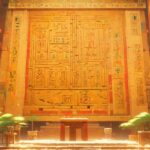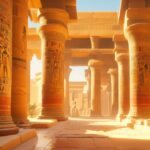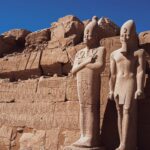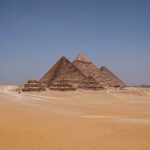Delve into the intriguing realm of Thutmose III, Ancient Egypt’s formidable pharaoh, as we unveil a collection of intriguing facts about his reign. With a wealth of knowledge and experience in ancient Egyptian civilization, our team of seasoned historians and archaeologists have meticulously researched and uncovered lesser-known aspects of Thutmose III’s rule. From deciphering hieroglyphics to analyzing archaeological findings, join us on a captivating journey as we unravel the untold stories and fascinating revelations surrounding this powerful pharaoh.

Key Takeaways:
- Thutmose III was an Egyptian pharaoh who played a significant role in transforming Egypt from a kingdom into an expansionist empire.
- He was the son of Thutmose II and a secondary wife named Iset or Aset. His aunt, Queen Hatshepsut, acted as his regent during his early rule.
- Thutmose III’s name translates to “Thoth is born,” referring to the ancient Egyptian god of wisdom and writing.
- He was a highly successful military leader, never losing a battle and making 17 profitable camping trips around Egypt.
- Under his rule, Egypt’s empire expanded from Iraq to the Sudan, solidifying his reputation as a conqueror.
- Despite his conquests, Thutmose III treated the conquered peoples well, leading to peace and prosperity.
- His military accomplishments are recorded on the numerous monuments he built, making him the richest man in the world at the time.
Interesting Facts About Thutmose III: Unveiling Ancient Egypt’s Formidable Pharaoh
Thutmose III, the mighty pharaoh of ancient Egypt, left an indelible mark on history through his military prowess and ambitious conquests. As we dig deep into the compelling realm of this formidable ruler, we unravel fascinating facts that shed light on Thutmose III’s extraordinary reign. Join me as we explore the intriguing world of Thutmose III and his contributions to ancient Egypt’s expansionist empire.
Early Life and Rule
Thutmose III’s journey to the throne was not a straightforward one. Born as the son of Thutmose II and a secondary wife named Iset, he found himself too young to rule when his father passed away. As fate would have it, his aunt, Queen Hatshepsut, stepped in as his regent, guiding him into his future role as Pharaoh of Egypt[^1^].
Meaning Behind the Name
Let’s delve into the meaning behind the name ‘Thutmose III.’ The name itself holds a significant connection to ancient Egyptian mythology. Translating to “Thoth is born,” it pays homage to Thutmose III’s divine heritage, as Thoth was the revered god of wisdom and writing[^2^].
Military Accomplishments
Thutmose III’s military prowess remains unparalleled in ancient Egyptian history. A fascinating fact about this legendary pharaoh is that there are no records of him ever losing a battle. Armed with strategic brilliance and tactical excellence, he embarked on seventeen successful military campaigns throughout Egypt, each fueling his growing empire^3^.
Expansionist Policies
Under Thutmose III’s rule, Egypt experienced a significant shift from an inward-looking kingdom to an expansionist empire. His conquests stretched far and wide, extending the borders of Egypt from Iraq to Sudan. This unparalleled expansion solidified Thutmose III’s reputation as a fearsome conqueror and unparalleled ruler^4^.
Treatment of Conquered Peoples
Contrary to common expectations of oppression and cruelty, Thutmose III surprised the world with his benevolent treatment of the peoples he conquered. Once integrated into the Egyptian Empire, these conquered territories often experienced peace and prosperity, benefiting from Egypt’s advanced governance and resources[^5^].
Monuments and Legacy
Thutmose III’s achievements and legacy are rooted in the numerous monuments he built throughout Egypt. These grand structures served as enduring testaments to his military triumphs and empire-building efforts. Notably, his achievements amassed such vast wealth that Thutmose III became one of the richest men in the world during his reign^6^.
In conclusion, Thutmose III’s reign stands as a pivotal moment in ancient Egyptian history, marking a transformative era of expansion and conquest. His remarkable military successes, benevolent reign, and extraordinary legacy continue to captivate historians and archaeologists to this day. As we delve into the intriguing world of Thutmose III, let us honor the enduring significance of this extraordinary pharaoh and his contributions to ancient Egypt.
Sources:
- National Geographic. (n.d.). Thutmose III—facts and information. Retrieved from here.
- Ducksters. (n.d.). Biography: Thutmose III. Retrieved from here.
[^1^]: Egypt United Tours
[^2^]: National Geographic
[^5^]: National Geographic
Check out these interesting fun facts about Tyreek Hill that will leave you amazed. Learn about his incredible accomplishments and fascinating personal life.
Thutmose III: Expansion of the Egyptian Empire
Thutmose III, the formidable pharaoh of ancient Egypt, is renowned for his military campaigns that expanded the empire’s borders and transformed Egypt into a powerful and expansive kingdom. With his expertise in war strategy and skilled warriors, Thutmose III conquered numerous cities and territories, including Nubia, Canaan, and southern Syria, solidifying Egypt’s control over lucrative trade routes along the Nile and gaining access to valuable resources like gold and precious stones.
The Military Conquests
Thutmose III’s journey of expansion began with his campaigns in Nubia. He successfully captured major cities such as Kerma and Napata, integrating them into the Egyptian Empire. These conquests not only established Egypt’s control over the region but also secured vital trade routes, paving the way for economic prosperity.
Changing Egypt’s Destiny
Under Thutmose III’s rule, Egypt underwent a significant transformation. The pharaoh shifted the focus of the kingdom from an inward-looking nation to an empire with expansionist ambitions. Through his seventeen military campaigns, Thutmose III extended Egypt’s influence beyond its borders, shaping the destiny of the empire.
Benevolence and Integration
Contrary to the image of a ruthless conqueror, Thutmose III’s approach to governance was marked by benevolence and integration. He treated the peoples he conquered with fairness and incorporated them into the Egyptian Empire. This allowed for cultural exchange and mutual growth, ultimately fostering a stronger and more diverse kingdom.
Monumental Triumphs
Thutmose III’s achievements are immortalized in the monuments he built throughout Egypt. These architectural wonders showcase his military triumphs and empire-building endeavors. From the grand temples of Karnak to the imposing statues in Thebes, these structures stand as a testament to Thutmose III’s reign and the expansion of the Egyptian Empire.
Key Takeaways:
- Thutmose III expanded the Egyptian Empire through successful military campaigns.
- His conquests in Nubia secured control over trade routes and valuable resources.
- The pharaoh transformed Egypt from an inward-looking kingdom to an expansionist empire.
- Despite being a conqueror, Thutmose III integrated the conquered peoples into the Egyptian Empire with benevolence.
- The pharaoh’s monumental constructions celebrate his military triumphs and reflect the expansion of the Egyptian Empire.
Sources:
– Ducksters: Biography: Thutmose III
– National Geographic: Thutmose III
Thutmose III: Architectural Achievements
From the majestic pyramids to the grand temples, ancient Egypt’s architectural wonders continue to captivate our imaginations. Amidst these remarkable structures, one pharaoh stands out for his architectural prowess and enduring legacy: Thutmose III. Known as one of the greatest military leaders and builders in ancient Egypt, Thutmose III’s architectural achievements shaped the landscape of Egypt and reflected the might and power of the empire.
Building an Empire, One Monument at a Time
Thutmose III’s reign was a golden era of construction and monumental building projects. His vision and ambition led to the creation of over 50 monumental structures that still stand today. From temples to statues, each structure served as a testament to Thutmose III’s military triumphs and empire-building efforts. His architectural achievements not only left an indelible mark on Egypt but also represented the aspirations and grandeur of the empire.
Temple Expansion and Construction
At the heart of Thutmose III’s architectural endeavors was the expansion and construction of temples. These sacred structures were not only places of worship but also symbols of power and divine authority. Thutmose III oversaw the expansion of existing temples, such as the Karnak Temple Complex in Luxor, ensuring their magnificence matched the empire’s growing influence. Additionally, he commissioned the construction of new temples, some dedicated to the gods, while others celebrated his military conquests. The Temple of Amun-Ra in Karnak and the Temple of Hathor in Deir el-Bahari are examples of his architectural marvels that still awe visitors today.
Naval Expeditions and Shipbuilding
Thutmose III’s architectural achievements were not limited to land. He recognized the importance of the navy in maintaining Egypt’s dominance and control over trade routes. As such, he commissioned the construction of ships, expanding the Egyptian navy to safeguard vital waterways and ensure Egypt’s prosperity. These ships were not only crucial for military campaigns but also served as symbols of Egypt’s maritime power and dominance.
Key Takeaways:
- Thutmose III’s architectural achievements encompass over 50 monumental structures that still stand today.
- He focused on the expansion and construction of temples, showcasing his military triumphs and empire-building efforts.
- The Temple of Amun-Ra in Karnak and the Temple of Hathor in Deir el-Bahari are among his most notable architectural marvels.
- Thutmose III recognized the significance of naval power and commissioned shipbuilding projects to expand the Egyptian navy.
Sources:
– Thutmose III Biography – Facts, Childhood, Family Life & Achievements
– Thutmose III | Pharaoh, Military Leader & Reformer
Thutmose III: The Temple of Amun at Karnak
In the realm of ancient Egyptian civilization, one pharaoh stands out among the rest—Thutmose III. Renowned as the “Napoleon of Egypt,” Thutmose III left an indelible mark on history through his formidable reign during the 18th Dynasty. His military prowess and empire-building efforts are immortalized in the remarkable Temple of Amun at Karnak.
A Conqueror’s Victories Inscribed in Stone
Thutmose III’s military exploits were truly unparalleled. Over the span of just 20 years, he conducted at least 16 military campaigns, capturing an astounding 350 cities and conquering vast territories from the Euphrates to Nubia. These remarkable victories were not just recorded in the annals of history but also inscribed on the sanctuary walls at the magnificent Temple of Amun at Karnak.
The Festival Hall: A Tribute to Nature’s Bounty
One of the captivating features within the Temple of Amun is the Festival Hall. This grand structure depicted the extraordinary flora and fauna that Thutmose III collected during his campaigns across Asia. Among the stunning depictions were 275 plants, offering a glimpse into the diverse natural world encountered by this formidable pharaoh.
The Expansion of Karnak: A Testament to Power
Thutmose III’s influence extended far beyond his military conquests. He recognized the importance of architectural prowess in solidifying his rule and expanding the Egyptian Empire. The Great Temple of Amon at Karnak, already an imposing structure, was further expanded by Thutmose III. Notably, his additions included the awe-inspiring hypostyle hall, a vast forest of towering columns that showcased the sophistication and grandeur of ancient Egyptian architecture.
Heliopolis: The Sun God’s Domain
In addition to his contributions at Karnak, Thutmose III left an enduring legacy in ancient Egypt through his construction projects. One notable achievement was the building of the sun god temple at Heliopolis. This city held great religious significance as a center for the worship of the sun god, and Thutmose III’s temple only added to its splendor.
Unveiling the Temple of Thutmose III
While the Temple of Amun at Karnak immortalizes Thutmose III’s military achievements, the pharaoh’s own temple is located at Deir el-Bahari in the Deir el-Bahari Valley. Known as the Temple of Thutmose III, it stands as a testament to his reign and the religious fervor that permeated ancient Egypt.
Key Takeaways:
- Thutmose III was an Egyptian pharaoh known for his military conquests and empire-building efforts.
- The Temple of Amun at Karnak served as a canvas for immortalizing Thutmose III’s victories, with inscriptions adorning its walls.
- The Festival Hall within the Temple depicted the diverse flora and fauna collected by Thutmose III during his campaigns.
- Thutmose III expanded the Karnak Temple Complex, adding architectural marvels like the hypostyle hall.
- His legacy extended to Heliopolis, where he constructed a sun god temple.
- The Temple of Thutmose III, located at Deir el-Bahari, stands as a testament to his reign and religious devotion.
Sources:
– National Geographic: Thutmose III—facts and information
– Wikipedia: Thutmose III
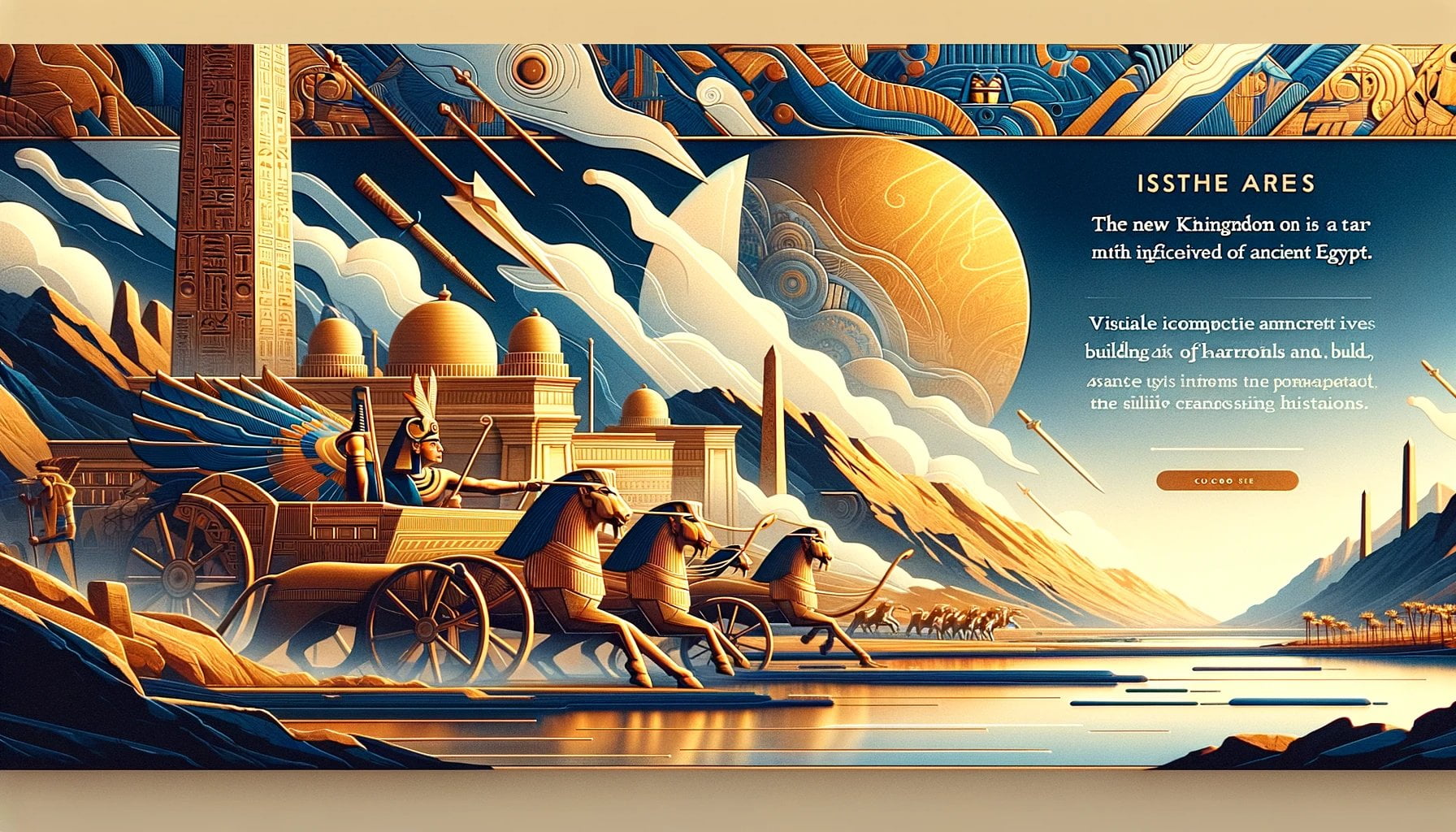
FAQ
Q1: What were some significant achievements of Thutmose III?
A1: Thutmose III achieved numerous conquests, expanding Egypt’s empire from Iraq to the Sudan. He conquered over 350 cities, solidifying his reputation as a conqueror.
Q2: How did Thutmose III treat the peoples he conquered?
A2: Despite his conquests, Thutmose III treated the peoples he conquered well. They generally experienced peace and prosperity after becoming part of the Egyptian Empire.
Q3: What is the meaning behind Thutmose III’s name?
A3: Thutmose III’s name translates to “Thoth is born.” Thoth was the ancient Egyptian god of wisdom and writing.
Q4: What was Thutmose III’s role during his early life and rule?
A4: Thutmose III’s father died when he was too young to rule, and his aunt, Queen Hatshepsut, acted as his regent until he came of age.
Q5: How did Thutmose III contribute to Egypt’s expansionist empire?
A5: Thutmose III’s military leadership and conquests played a crucial role in transforming Egypt from an inward-looking kingdom into an expansionist empire.
- Amazing March Fun Facts: Unveiling History & Celebrations - April 15, 2025
- Master how to write height: A complete guide - April 15, 2025
- How High Are Your Standards Test: Find Your Perfect Match Now - April 15, 2025

